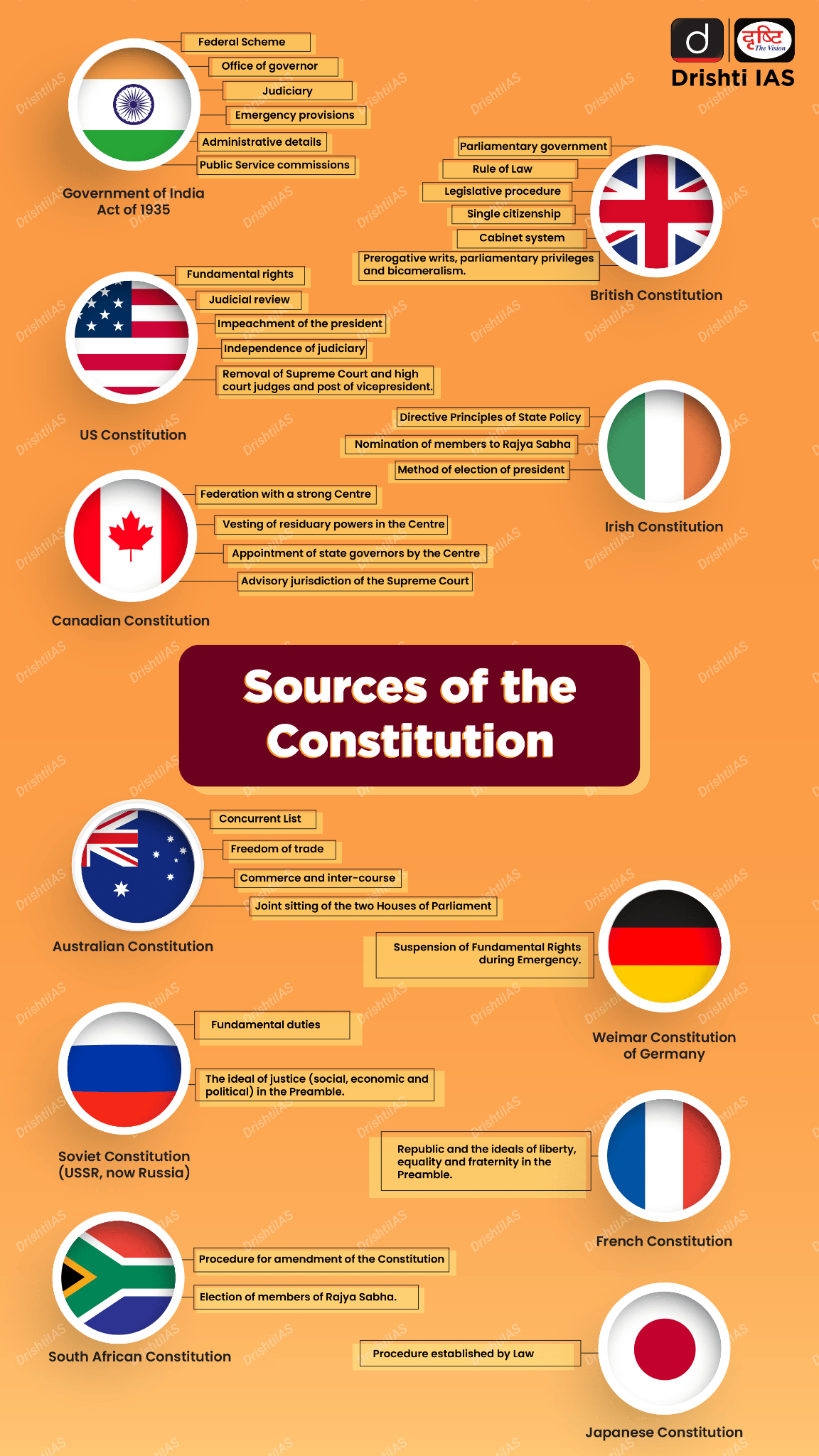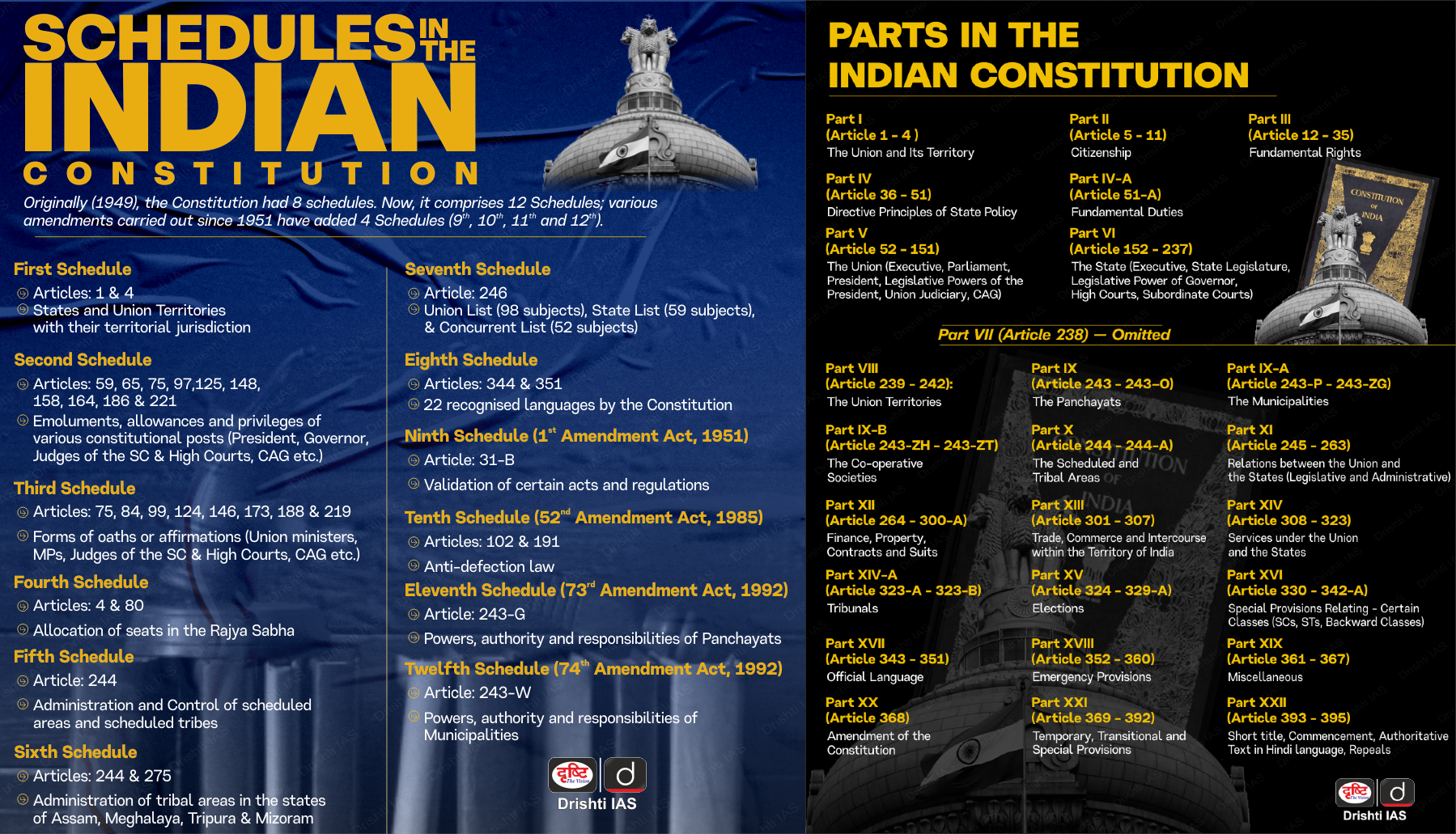Constitution Day 2024 | 27 Nov 2024
For Prelims: Constitution Day, Supreme Court of India, 26/11 Mumbai Attacks, Article 370, Sarojini Naidu, Basic Structure of the Constitution, Right to Privacy, Fundamental Right, Directive Principles of State Policy, Preamble
For Mains: Constitution and Its Evolution, Global Influence on the Indian Constitution, Drafting of the Indian Constitution, Key Features of the Constitution of India
Why in News?
On Constitution Day, 26th November 2024, the Prime Minister of India joined celebrations organized by the Supreme Court of India, marking 75 years since the adoption of the Indian Constitution. He emphasized the Constitution as a living document crucial for socio-economic progress and justice.
- The occasion also commemorated the victims of the 26/11 Mumbai attacks, underscoring India’s resilience.
What is Constitution Day?
- About: Constitution Day marks the adoption of the Indian Constitution on 26th November 1949. It celebrates India's democratic values and promotes awareness of justice, liberty, equality, and fraternity.
- In 2015, the Ministry of Social Justice and Empowerment declared 26th November as Constitution Day to deepen citizens' connection with the Constitution. Before 2015, 26th November was observed as National Law Day.
- The day honours the Constituent Assembly's vision in drafting the Constitution and Dr B.R. Ambedkar's pivotal role as Chairman of the Drafting Committee, earning him the title "Father of the Indian Constitution."
- Key Highlights of the Constitution Day 2024:
- Constitution Day Celebrations in Jammu and Kashmir: For the first time in 74 years, Jammu and Kashmir celebrated Constitution Day, following the abrogation of Article 370 in 2019.
- The event symbolized a new chapter in the Union Territory's alignment with India's legal and political framework.
- Hamara Samvidhan, Hamara Samman: The Minister of Labour and Employment participated in the "Hamara Samvidhan, Hamara Samman" campaign.
- The "Hamara Samvidhan, Hamara Samman" campaign, launched on 24th January 2024, aims to deepen citizens' understanding of the Constitution and its role in shaping Indian society.
- This is a year-long initiative promoting constitutional awareness, legal rights, and responsibilities.
- The campaign includes regional events, workshops, and seminars, along with sub-campaigns like Sabko Nyay, Har Ghar Nyay (justice for all), Nav Bharat, Nav Sankalp (new resolve for a new India), and Vidhi Jagriti Abhiyaan (legal awareness).
- The campaign aligns with India’s vision for a developed nation by 2047.
- The "Hamara Samvidhan, Hamara Samman" campaign, launched on 24th January 2024, aims to deepen citizens' understanding of the Constitution and its role in shaping Indian society.
- Women of India's Constituent Assembly: The President of India highlighted the contributions of 15 women members in the Constituent Assembly, including Sarojini Naidu, Sucheta Kripalani, and Vijaya Lakshmi Pandit.
- Lesser-known members like Ammu Swaminathan, Annie Mascarene, Begum Qudsia Aizaz Rasul, and Dakshayani Velayudhan were also recognized for shaping India’s Constitution.
- Ammu Swaminathan: From Kerala, she entered politics after witnessing social restrictions on widows. Advocated for gender equality through the Hindu Code Bill, enduring male-dominated ridicule in the Assembly.
- Annie Mascarene (1902-1963): She campaigned for universal adult franchise against casteist opposition.
- Begum Qudsia Aizaz Rasul (1909-2001): A member of the Muslim League, she opposed religion-based electorates despite complex views on Partition.
- Dakshayani Velayudhan (1912-1978): The first Dalit woman graduate in science and the first Dalit woman in the Cochin Legislative Council. Opposed separate electorates for Dalits, emphasising nationalism.
- Constitution Day Celebrations in Jammu and Kashmir: For the first time in 74 years, Jammu and Kashmir celebrated Constitution Day, following the abrogation of Article 370 in 2019.
What Makes the Indian Constitution a "Living Document"?
- Amendability: The Indian Constitution can be amended to address changing needs and circumstances. This flexibility allows it to evolve over time while maintaining its core principles.
- Provision for Amendments: Article 368 in Part XX grants Parliament the power to amend the Constitution by addition, variation, or repeal of any provision, following the laid-down procedure.
- Parliament cannot amend the 'basic structure' of the Constitution, as ruled in the Kesavananda Bharati vs State of Kerala case, 1973 by the Supreme Court.
- Types of Amendments: Amendments to the Constitution can be made in 3 different ways, by a simple majority of Parliament, by a special majority of Parliament, and special majority + state ratification for some amendments.
- Amendments under the simple majority category do not fall under Article 368.
- Provision for Amendments: Article 368 in Part XX grants Parliament the power to amend the Constitution by addition, variation, or repeal of any provision, following the laid-down procedure.
- Judicial Interpretation: The judiciary, particularly the Supreme Court, plays a crucial role in interpreting the Constitution.
- Landmark judgments and evolving interpretations ensure that the Constitution remains relevant and responsive to contemporary issues.
- Courts have interpreted provisions to meet contemporary needs, such as recognising the Right to Privacy as a Fundamental Right in the K.S. Puttaswamy v. Union of India, 2017
- Federal Structure: The federal structure of the Indian Constitution balance of power between the central and state governments, addressing regional needs and diversity.
- Article 246 outlines three lists in the Seventh Schedule: Union, State, and Concurrent. The Centre legislates on the Union List, states on the State List, and both on the Concurrent List, with Union laws prevailing in case of conflict.
- Hybrid Structure of the Constitution: Certain provisions are rigid, protecting fundamental values like federalism, and secularism.
- Other provisions, such as the Directive Principles of State Policy (DPSP), allow for flexible adaptation to meet the welfare needs of society.
- Responsive to Social Change: The Constitution of India has provisions that allow it to respond to social changes, such as the inclusion of new laws to protect marginalized communities and promote social justice.
- For example, the 89th Amendment Act of 2003 made the National Commission for Scheduled Tribes (NCST) a constitutional body under Article 338A, and the National Commission for Scheduled Castes (NCSC) a separate constitutional body under Article 338, enhancing their roles in creating a more inclusive society
What are the Key Facts about the Constitution of India?
- Constituent Assembly: The Constituent Assembly took nearly three years (2 years, 11 months, 17 days) to draft the Constitution. Initially, it had 389 members, with 292 elected from Provincial Legislative Assemblies, 93 from Princely States, and 4 from Chief Commissioners' Provinces.
- However, following the partition of India in 1947 and the creation of Pakistan, a separate Constituent Assembly was formed for Pakistan, reducing the membership of India’s Assembly to 299.
- Original Structure (1949): Initially, it contained a Preamble, 395 Articles (divided into 22 Parts), and 8 Schedules.
- Current Structure: It now includes a Preamble, more than 450 Articles (divided into 25 Parts), and 12 Schedules.
- Amendments: As of September 2024, there have been 106 amendments of the Constitution of India since it was first enacted in 1950.
- Length: The Constitution of India is the lengthiest written Constitution in the world.
- It was handwritten by Prem Behari Narain Raizada in calligraphy, with pages decorated by artists from Shantiniketan under Nandalal Bose’s guidance.
- Reason for Extensive Size: The vastness and diversity of India have necessitated a detailed constitutional document.
- The influence of the Government of India Act of 1935, which itself was a comprehensive document, has contributed to the Constitution’s size.
- India’s single unified Constitution, which governs both the central and state governments, also added to its size.
- The Constituent Assembly, led by legal experts, crafted a Constitution that is both thorough in legal and administrative aspects, encompassing fundamental governance principles as well as detailed administrative provisions.
- Furthermore, the Constitution draws from various global sources, with provisions inspired by the American, Irish, British, Canadian, Australian, German, and other constitutions, reflecting the broader international influence on its design.
- Criticisms of the Indian Constitution:
| Criticism | Debunking |
| Borrowed Constitution | The framers adapted and modified borrowed features to suit Indian conditions, avoiding their faults. |
| Carbon Copy of the Government of India Act, 1935 | While many provisions were borrowed, the Constitution is not a mere copy. It incorporates significant changes and additions. |
| Un-Indian or Anti-Indian | The Constitution reflects Indian values and aspirations, despite borrowing from foreign sources. |
| Un-Gandhian | While not explicitly Gandhian, the Constitution aligns with many of Gandhi's principles, particularly in the DPSP. |
| Elephantine Size | The Constitution's detailed nature is essential for managing India's diversity and complexity. |
| Paradise of the Lawyers | The legal language is essential for clarity and enforceability. |
|
Drishti Mains Question: The Indian Constitution is often referred to as a 'living document.' Analyse its ability to adapt to changing circumstances. |
UPSC Civil Services Examination, Previous Year Questions (PYQs)
Prelims
Q. What was the exact constitutional status of India on 26th January, 1950? (2021)
(a) A Democratic Republic
(b) A Sovereign Democratic Republic
(c) A Sovereign Secular Democratic Republic
(d) A Sovereign Socialist Secular Democratic Republic
Ans: (b)
Q) Who among the following was the chairman of the Union Constitution Committee of the Constituent Assembly? (2005)
(a) B.R. Ambedkar
(b) J. B. Kripalani
(c) Jawaharlal Nehru
(d) Alladi Krishnaswami Ayyar
Ans: (c)
Q. The distribution of powers between the Centre and the States in the Indian Constitution is based on the scheme provided in the (2012)
(a) Morley-Minto Reforms, 1909
(b) Montagu-Chelmsford Act, 1919
(c) Government of India Act, 1935
(d) Indian Independence Act, 1947
Ans: (c)
Mains
Q. It would have been difficult for the Constituent Assembly to complete its historic task of drafting the Constitution for Independent India in just three years but for the experience gained with the Government of India Act, 1935. Discuss. (2015)
Q. Examine the scope of Fundamental Rights in the light of the latest judgement of the Supreme Court on Right to Privacy. (2017)
Q: Though the federal principle is dominant in our constitution and that principle is one of its basic features, but it is equally true that federalism under the Indian Constitution leans in favour of a strong Center, a feature that militates against the concept of strong federalism. Discuss. (2014)




